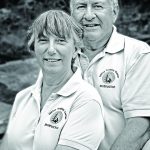This is a delicate topic. You’ve been given your dad’s old hunting rifle. Maybe it was your granddad’s before him. It’s filled with cherished memories. You have been chosen to honour it, maybe even pass it down to your own little hunters. But do you know if it’s right for hunting?
Here are some questions to ask yourself.
What kind of hunting do you plan to do?
There is an ideal firearm for every hunt — and every capability hunter. You may be willing to compromise, but you need to be aware of the consequences.
The rifle standing position?
Modern hunters do everything they can to ensure a precise shot. They use rests for the rifle, often in a stand, often shooting from a sitting position.
Some rifle stocks are meant specifically for the standing position (the offhand position). The buttstock drops to provide good contact with the shoulder and present the sights at eye level. They are not so comfortable to shoot in other positions, specifically prone — the steadiest position. Are you planning to use the standing position? Are you practiced enough to take an offhand shot at a deer?
What size of person are you?
Most older stocks are longer in the butt than they need to be for the average-sized person. They were made as a “one size fits all,” and as we know now, it’s more like “one size fits none.” In our gunsmithing business, we’ve found that an average length of pull for a hunting rifle is about 13 inches (see photo, below) ― shorter if you’re wearing a heavycoat, as you might during Ontario’s deer season.

How much practice do you get?
In the old days, dad or granddad likely would have been able to go out and shoot in the field behind the house. Many of our forebears went varmint hunting, getting lots of practice on small targets at various distances.
Nowadays, you usually need to belong to a shooting club, and the distances will usually be fixed at 50 or 100 yards. Most clubs only allow shooting from a bench, so you just don’t get the practice you need shooting from positions, especially not from unsupported positions like offhand.
We recommend lots of dryfiring to ensure that you have the fundamental skills, but until you’ve felt the kick from Dad’s .30-06 with a skinny barrel and a long buttstock, you haven’t really practiced. Practising with your hunting rifle should be fun and it’s not fun if it hurts to fire a shot, nor is it conducive to good marksmanship.
Is it the right calibre?
The first rule of calibre is to ensure it’s appropriate for the hunting situation.
Does it do the job efficiently and effectively? Is it overkill? For example, if you’re hunting deer, you don’t need a magnum.
Is modern ammo available and suitable for it?
Keith’s granddad’s favourite deer rifle was a Remington Model 14 in .44-40. This is a cartridge that would provide effective shots at a range comparable to that of a modern bow.

Can you shoot it well?
It may need to be handy in the bush, but more importantly, can you shoot it well? Can you use it in positions, on sticks, from your stand?
Does it need a muzzle brake to tame recoil and keep you shooting effective shots?
When we asked our safari guide what we should bring to Africa, he said, “Bring what you can shoot well.”
Is it in good condition?
Is the rifle in good condition? Does the safety operate properly? Can it load and unload properly? Does the magazine operate correctly? Can it pass the slamfire test? Can the barrel be unobstructed and thoroughly cleaned? Is the rifling in good condition? Is the chamber clean and smooth, with no pitting? Are the sights accurate (and adjusted for you)? Keith’s grandad’s old .44-40 had an unsettling habit of firing when bumped just right.
Is it fitted with a scope?
A good modern hunting rifle is far easier to use accurately if it’s fitted with a good-quality telescopic sight. Open sights or peep sights require a lot more aiming skill to ensure that the sights are properly aligned. The scope takes care of this. With an optic sight, a more ethical shot can be applied under dusk and dawn light.
Here’s the final test question
If you didn’t already have this gun, would you go out and buy one like this right now?
In case of doubts
If you don’t think this is the best rifle for your hunt, be honest with yourself. Honour the rifle as you would honour your trophies…put it in a place of respect in your home. Don’t take it to the field.
We know our dads would have wanted us to hunt with the right rifle, the best one available for the job. They would expect us to work hard to guarantee the most ethical shot possible. And that’s far more important than taking their rifle on a hunt.

Linda and Keith own and operate the MilCun Training Centre (www.milcun.com) near Haliburton, Ontario. They are the authors of Amazon bestsellers The Wind Book for Rifle Shooters and The Secrets of Mental Marksmanship. Reach Linda or Keith at [email protected]
Originally published in the April 2022 issue of Ontario OUT of DOORS
